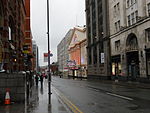3 Hardman Street
Glass architectureOffice buildings completed in 2009Office buildings in ManchesterSkyscrapers in Manchester

3 Hardman Street is a 16-storey high-rise building in Spinningfields, Manchester, England. At 75 m (246 ft), as of 2023 it is the third-tallest building in the Spinningfields area (after 1 Spinningfields and the Manchester Civil Justice Centre) and the joint 36th-tallest building in Greater Manchester.
Excerpt from the Wikipedia article 3 Hardman Street (License: CC BY-SA 3.0, Authors, Images).3 Hardman Street
Hardman Street, Manchester City Centre
Geographical coordinates (GPS) Address External links Nearby Places Show on map
Geographical coordinates (GPS)
| Latitude | Longitude |
|---|---|
| N 53.4797 ° | E -2.2503 ° |
Address
Hardman Street 3
M3 3AT Manchester, City Centre
England, United Kingdom
Open on Google Maps











